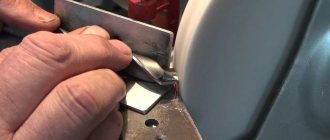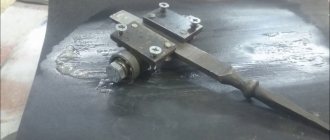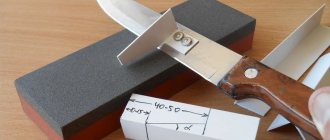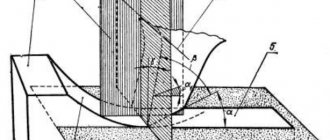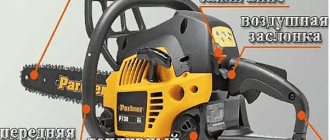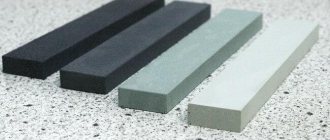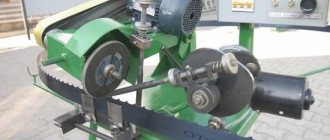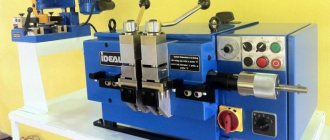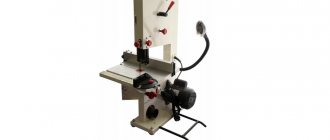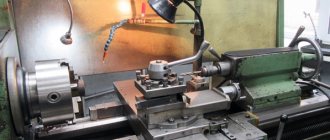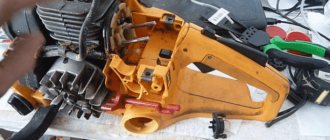Types of saws
Band saws can be distinguished by the type of teeth, taking into account the configuration of which the required sample is selected for processing a certain type of material.
The selection of the configuration of the saw teeth is based on the characteristics of the lumber, in particular, on the parameters of its hardness: the denser the wood, the smaller the rake angle of the blade cutters and the pitch between them will be. By following this rule, it is possible to significantly improve the quality of the cut and extend the service life of the tool.
Cutting thin materials is usually carried out using a saw blade that has a standard or small pitch between the cutters, otherwise the risk of damage to the working tool increases many times over. A saw with a large pitch of teeth is designed to use it to cut thick-walled metal or wood workpieces that must be firmly fixed before starting the processing process.
Saw teeth set
If the saw begins to bend or get stuck in the cut, re-set the teeth. Prepare the mandrel for work: loosen the locking screw and turn the fence, aligning the tooth size indicated on it (corresponding to your saw) with the mark on the fixture. Tighten the locking screw and set each tooth that should be tilted away from you. Turn the saw over and repeat the operation with the other teeth. Check to see if you have missed a tooth by holding the saw at eye level with the teeth facing away from you.
Band saw design
Band saw machine
The band saw belongs to the category of cutting tools and is an integral part of specialized wood processing equipment. It is a closed belt with teeth on the outer edge.
For production, special grades of steel are used - 9ХФ, Б2Ф or С75. During the production process, teeth are treated with high-frequency currents. This increases their hardness. It is this fact that affects the spread of cutting edges and maintainability. Often several types of steel are used in manufacturing. The main belt is made of spring, and the cutting part is made of steel with a high content of tungsten or cobalt.
Features of using band saws for wood:
- wood requirements. The harder it is, the faster the blade will become dull;
- installation conditions. The tension indicator must be observed. If it is less than required, sagging will occur. With strong tension, the likelihood of fabric breakage will increase;
- periodic sharpening. This will require a special machine.
Completing the last point will increase the service life of the strip structure. However, sharpening it yourself is problematic - you need to choose the right layout and maintain the angle of the blades.
Materials and their characteristics
Before starting work, you should know what the band saw (tape) is used for, what materials are used and what parameters should be maintained when sharpening bands.
A band saw is a specialized tool for cutting wood in special machines. The blade of such a tool is a closed strip, which may have teeth or a flat, sharp cutting edge (toothless). Such woodworking equipment makes very accurate and very thin cuts, which allows them to be used for finishing work, working with valuable wood, as well as for making both longitudinal and transverse cuts and cuts at any angle and in any plane of the material. Their advantages include high speed of material processing, long service life of the cutting edge and accuracy of the cut line. In order for the saw to always be ready for use, as well as for a high-quality cut, it is necessary to constantly sharpen the cutting edge, and when it wears out, it is necessary to sharpen it completely.
The device of the sharpening machine.
For the manufacture of blades, steel 9ХФ or В2Ф is most often used. Such steels have a hardness of 45-55 on the Rockwell scale. Harder steels are practically not used. Low hardness is not capable of maintaining the sharpness of the cutting edge for a long time, especially when the tool is used frequently. So, after processing hard wood, you need to sharpen the saw. Exceptions are saws for processing metal and metal products: they often use steel 100Х18В4 or analogues, the hardness of which is 90-95 points on the Rockwell scale. True, not the entire saw is made of such a high-strength alloy, but only the teeth and 2-3 mm of the cutting edge, which is connected to the rest of the blade with a special laser. Sharpening such saws without the appropriate tool is difficult, and at home it is impossible. They are sharpened in specialized centers, so the process of sharpening them will not be considered in this material.
Monitoring the level of wear of the cutting edge occurs visually when monitoring the cut; the operating time of the saw can also be monitored (for comparison, you should measure the cutting speed of workpieces of the same diameter with a sharp and blunt blade). This is done quite simply: a blunt tape makes uneven (torn) surfaces at the cut site.
Read also: Magnetic starter for lighting
Sharpening the saw
When using the saw, the quality of the cut decreases due to blunting of the cutters and a decrease in the width of their setting. Therefore, in order to improve cutting properties, it is necessary to sharpen the cutting edges of the band saw. Instructions for performing the work:
- Wiring.
- Turning.
At home, tooth alignment can be done in the following ways:
- classic: sequential bending in the direction corresponding to the design;
- stripping: bending two adjacent teeth in both directions, and leaving the third one unchanged in the initial position;
- wavy: each tooth is set apart by a different amount in the form of a wave.
Sharpening is performed in the following sequence:
- Grinding wheels are selected taking into account the hardness of the material. To process tool steel, corundum discs must be used. Bimetallic tools can be sharpened with diamond discs.
- Emery for tape. Available in the following shapes: disc, flat, cup, profile.
- The tape should be cleaned of dirt, oil stains, and shavings. Then turn it in the opposite direction with the teeth and hang it indoors for 12 hours.
- Perform sharpening with prepared tools.
Basic rules for sharpening saws:
sharpening of teeth is carried out on one or both sides of the blade; It is necessary to remove equal layers of metal from the teeth so that the cutting line is formed evenly and the edges are smooth; when turning with circles, it is unacceptable to strongly press the sharpened edges against the abrasive surface in order to prevent annealing of the metal and loss of mechanical properties; Water cooling is required to cool the tool during operation; it is important to maintain the geometry of the blade and teeth; If burrs are found, they must be removed.
Correctly spreading the teeth should not be completely flat, but bend only 1/3 or 2/3 from the top. According to manufacturers' recommendations, the bend value is from 0.3 to 0.7 mm.
Let's start sharpening
To service saws, it is not enough to sharpen the teeth; you also need to separate them. Both of these operations are performed sequentially, starting with spreading the teeth and ending with sharpening. It is necessary to strictly adhere to this sequence of work. The layout is done in order to reduce the friction of the blade against wood or metal (or other material being processed). There are several layout options, which depend on what parts are required to be obtained after processing and the hardness of the original workpiece.
Otherwise, the tape may get jammed. Most often, alternate wiring is used. In this case, the teeth are bent sequentially in different directions from the vertical plane of the tape. Wiring for cleaning surfaces is less common. Its distinctive feature is that every third tooth does not bend, but the first two bend in different directions. The most complex, but relatively frequently used, is the wavy layout. This type of set differs from the others in that each tooth has its own set angle. Separating the teeth at home can be easily done with pliers. To do this, you need to fix the tape motionless and move your teeth apart while working, carefully maintaining the angles. When setting, not the entire tooth is bent, but only 2/3 (sometimes ½) of its length.
When the tape is spread apart, sharpening can be done. To do this, you need to select the necessary grinding wheels and a machine for them. The composition of the circle material is selected based on the hardness and material of the blade. It is also important to choose the shape of the sharpening stone - it depends on the type of cutting edge of the tape. It is the shape of the sharpening stone that determines the angle of “sharpness” of the tape. Sharpening work should begin by installing the whetstone on the machine, securing it to it, after which the saw blade is fixed motionless in special clamps. The sharpening process itself is simple: the whetstone is untwisted (mechanically or electrically) and then lowered onto the blade (or moved closer). This is how one tooth is sharpened, then the stone is moved to the next one. When the entire cutting edge within the sharpening stroke is sharpened, the blade is shifted to sharpen the raw teeth. To prevent re-sharpening, use a marker to mark the “starting” teeth.
Sharpening band saws with a narrow abrasive wheel.
Currently, this method is becoming a thing of the past. Machines for sharpening band saws with a bakelite or ceramic wheel have many different adjustments and it is quite difficult for a novice master to take into account all the nuances, as well as avoid mistakes. These include burns, rough surfaces (burrs), lack of bosom grooves, and the formation of irregular angles of band saw teeth. As mentioned above, all this leads to the inevitable failure of the cutting tool.
Perhaps the only advantage that can be highlighted is the relative low cost of machines and equipment.
Factors influencing the correct sharpening of band saws when using narrow abrasive wheels:
- technical factor (correct adjustment of the machine along all axes, entry and exit angles, groove height, metal removal depth)
- instrumental factor (correct selection of grinding disc, formation of the angle of attack of the disc, grain size, etc.)
- the human factor (often laziness and lack of proper attention on the part of the master plays an evil role and leads to sad consequences)
Sharpening band saws with a borazon (CBN) disc.
Preparing cutting tools for use on machines using diamond tools is a modern and reliable way to avoid problems when sawing sawlogs and obtaining the correct geometric dimensions of lumber.
Unlike narrow circles, CBN exactly repeats the profile of the teeth of a band saw. Constantly rotating on an axis, the circle makes up and down movements, grinding through the sinus, corners, relieving tension in one pass. The process occurs automatically, the band saw is pushed by a special drive pusher.
The accuracy of sharpening depends on the correct selection of the grinding wheel profile. The most commonly used band saw profiles are:
The 4°/32° profile is a rarely used profile, designed for extra-hard wood, dry wood and for use in the cold season. Profile 9°/29° profile is designed for hardwood in the cold season. The 10°/30° profile is a universal profile, most often used in the southern and middle zones with mild climates. 13°/29° profile is more suitable for soft wood, increases cutting speed
The service life of CBN discs depends on the following factors:
1) the correct selection of “saw profile - sharpening disk profile” (if this point is violated, the sharpening disk will “go bald” in places where there is a discrepancy)
2) quality and layer of borazon coating
3) reliable supplier (we supply only high-quality CBN grinding wheels, proven by experience and time, from manufacturers such as Wood-Mizer and Astron)
4) the presence of a cooling system and the correct choice of coolant
5) correct adjustments
6) condition of sharpening equipment.
We would like to tell you about typical errors that occur during the process of sharpening and routing the tape.
1.
Such cracks occur due to improper installation of guide rollers. As a result, the back of the saw constantly rubs against the side of the roller during operation.
2.
In this case, the tape quickly becomes dull. The cause of this type of error is too much pressure on the grinding wheel during the sharpening process.
3 and 3a. It is visually noticeable that when sharpening the grinding wheel passes through an incomplete tooth profile. There is an error in setting the angle of the sharpening machine head or in the profile of the sharpening stone if a non-borazon CBN disc is used.
In addition, the reason may lie in the development of the eccentric of the sharpening machine. Cracks appeared in the place that was not machined.
4 and 4a.
Zero angle of attack - the belt rattles a lot during operation, which leads to vibration of the sawing head. In this case, cracks appear on the body of the saw in the place indicated by the circle.
The cause is incorrect installation of the sharpening machine head. With a very small (4a) tooth height, the tape begins to “wave” due to the fact that the sinus is not large enough to throw out sawdust, which in this case is very small (dust).
5.
The tooth is not sharpened completely. The reason for this is the off-axis installation of the sharpening machine head in relation to the clamp. The tape will quickly become dull.
6.
Too much tooth set. The cutting edge of the tooth (top) is not equidistant from the edge of the groove of the tape, which becomes dull very quickly. There are significant jerks of the head during cutting.
The service life of a wood band saw directly depends on the quality of its sharpening. It can be done either independently or using the services of specialized companies. In the first case, it is necessary to familiarize yourself in detail with the technology and a number of features.
How to sharpen a band saw correctly
Let us immediately note that if you do not have the experience and skills to perform such work, it is better to entrust saw sharpening to professionals. Violation of the geometry of the teeth of the cutting edge, the appearance of scale on the metal or incorrect routing significantly reduces the service life of the blade.
Having decided to sharpen a band saw with your own hands, it would be useful to first familiarize yourself with the key definitions, the knowledge of which may be required during the work process. So, for the correct formation of the cutting edge you will need:
- setting - deviation of the teeth from the plane of the main saw blade;
- tooth height - the distance between the top point and the base;
- pitch - the distance between the teeth, usually varies between 19-25 mm.
- sharpening angle – depends on the intended purpose of the tool; for example, the recommended sharpening angle for carpenter saws is 35°, for dividing saws – 18-22, for sawing timber – no more than 15°.
The sharpening angle is determined by the manufacturer, so when you edit the saw yourself, it is recommended to adhere to these parameters.
We provide detailed instructions that will help you sharpen a closed saw correctly without resorting to the services of specialists.
Wiring
Setting up band saws for wood is the first stage of restoring the profile of the cutting edge. During operation, the arrangement of the teeth may change, so until the correct geometry is achieved, there is no point in sharpening the saw part.
There are 3 ways to split the saw:
- classic - the teeth alternately deviate to the right and left;
- stripping - the 1st and 2nd teeth deviate in different directions, the third remains straight. This profile is created for sawing hard materials;
- wavy - the most complex option, resembling a wave in shape. Here, each tooth is given an individual shape, and this type of setting is usually performed only in specialized workshops.
It should be noted that when setting, not the entire tooth is bent around, but about 2/3 of the upper part. The procedure is performed on a special machine for setting band saws. The cost of such a tool is quite high, so it is bought if you need to set up several tools. Its presence can become the basis of a sharpening business.
Of course, it may not be possible to do everything correctly the first time, even on an adjusting machine, so at a minimum the profile geometry should remain the same as before the work began.
Sharpening
This is the main stage of cutting edge dressing and can be done in two ways.
Full-profile sharpening of saws is performed with a CBN wheel installed in a special sharpening machine.
This is a fully automated operation used by professionals. The operation of the machine for sharpening band saws for wood is controlled electronically, and the grinding wheel processes the entire band in one pass. The disadvantage of this method is that the CBN wheel is selected individually to the profile of the saw, so in order to edit different tools, the sharpening element must be included in the range.
Sharpening of teeth is done manually or using specialized equipment.
In the first case, you can restore the sharpness of the teeth in the shortest possible time, but the work requires certain skills. In the second - painstaking work: 4-5 movements along the edge of each tooth.
Diamond, CBN and corundum wheels are used for automatic sharpening
It is important to understand that when performing this procedure, only sharpness is given to the teeth; the geometry created after setting the blade must remain unchanged
This is interesting: Glass interior doors made of frosted glass: consider in detail
Video: Setting Up a Sharpening Machine for Band Saws Video
Choosing a high-quality grinding machine is quite difficult, but more and more truly high-quality tools are appearing on the modern market. With the advent of automatic dust sharpening tools, the quality of the process has also improved, since the human factor in such a process is minimized, which means incorrect angles of sharpened teeth or clogging of sinuses.
Among the quality cars there are models from several brands.
"Cedar". One of the most common and famous brands. This tool is a fully automatic machine that works thanks to an installed program. This also includes constant monitoring and use of coolant for normal operation. "Cedar" is quite easy to use and is suitable even for beginners. Adjusting the angle manually is also not difficult, just unscrew the two special screws located on the back of the tool and adjust the angle using the screw on the base. The tool also has a blade speed regulator.
More modern options allow the use of diamond grinding wheels.
"Taiga". The brand is no less famous than the previous one, has almost the same characteristics, and is even easier to manage. The blade angle and feed speed can also be easily adjusted on the tool.
This machine can be used for both wide and narrow band saws.
AZU-02. The most modified of all previous cars. All models have a special device for automatic coolant supply. The tool has several switches that allow you to fully control the operation of the grinder. And all models use diamond blades, which speed up the work process and improve its quality.
AZU-02 is still capable of regulating high-speed Internet traffic, which also greatly simplifies the process.
"PSLL 30/60 pro." Modern fully automatic machine with high sharpening speed. A special cooling oil is used to cool this machine. This machine does not require any professionalism and you only need surface control as the machine switches off when grinding one circle of saw blades.
"PZSL 10/2". Narrow band saw machine, suitable for both wood and metal saws. This block, like the previous one, is oil cooled. The process is completely automated, the master’s task is only to establish the desired process and bring the canvas to the machine, then the machine itself will do all the work.
Astron (A-1). Full-bore machine with borazon; the process of working with such a unit is fully automated. The machine cuts the entire saw in 1 complete pass. The sharpening disc is used for sharpening, which is of high quality and durability. Setting up the process is very simple and does not require high professionalism.
On the modern tool market there is a huge variety of grinding machines, the simplest and most popular grinding machines.
tips
If you want to sharpen a tool efficiently and easily, then when working you must observe the following:
- fully automatic devices must use a special liquid, otherwise the device will overheat and break;
- remove the same layer of material from each stud while sharpening;
- After work, there should be no burrs or burrs on the teeth;
- all work must be performed with the same pressure on the tool and at the same angle;
- the workplace must be clear and free of obstacles;
- There should always be a first aid kit;
- Protective clothing must be worn during operation.
There may be some difficulties when performing work without special education and experience, so it is best to hone at least some knowledge and skills in this area.
To summarize, we can say that the use of special grinders for band saws greatly simplifies and speeds up the work process, but it is important to follow the instructions and all recommendations, and also do not forget about safety rules. Watch how to sharpen a band saw on a grinder in the following video
Watch how to sharpen a band saw on a grinder in the following video.
All rights reserved, 14
Use of any materials without our prior written consent is prohibited.
How to properly sharpen a blade?
According to statistics, more than 80% of cases of device ruptures occur due to failure to perform sharpening techniques. The need for sharpening is revealed visually - by the appearance of the teeth themselves or the state of the cut site (increased unevenness of the plane).
Stones for sharpening band blades are selected based on the hardness of the teeth. Corundum stones are used to sharpen products made of carbon and alloy steel. Bimetal blades require borazon (CBN) or diamond discs. The configuration of the sharpening wheel for blades must be determined based on the characteristics of the tool. It can be plate-shaped, flat, cup-shaped, or profiled.
Before starting work, it is advisable to let the canvas hang in the twisted position for 10–12 hours.
Conditions for sharpening blades with your own hands:
- ensuring systematic removal of metal according to the cross-sectional shape of the tooth;
- avoiding excessive pressure on the disk (this can cause annealing);
- ensuring the integrity of the height and shape of the tooth section;
- the indispensable presence of liquid for cooling;
- checking the absence of scuffing.
By and large, despite the abundance of rules and conditions, these devices are quite undemanding in terms of sharpening. You can work with them either using a specialized sharpener for tape blades or manually. In addition, circles of different configurations and substances can be used for processing.
Before sharpening your band blade, it is advisable to become familiar with the key techniques for performing this procedure.
Method 1: Full profile sharpening
This method is considered to be of particularly high quality and is performed on automatic equipment. An Elbor (borazon) disk, precisely selected according to its configuration, processes the entire interdental cavity in a single pass, together with the corresponding planes of adjacent teeth. This prevents the formation of an uneven configuration at the base of the teeth. One drawback of such sharpening is to constantly have on hand a specific number of spheres for blades for different purposes.
Method 2: Sharpening the tooth edges
Can be performed on specialized equipment or manually.
If special equipment is selected, then it is necessary to competently select a circle - as a rule, these are flat-shaped samples. By and large, it is advisable to turn to professional sharpening equipment only in situations where the scale of the work is quite large. It is preferable to do irregular “household” work by hand - using an engraver or on an ordinary machine. During work, for your own safety, you must always use a mask or safety glasses.
Basic Information about Band Saws
A band saw is a cutting tool made in the form of a toothed band with a closed contour. To service it, you need a special sharpening machine for band saws. In addition, band saws have a number of other significant differences from traditional circular models. The most significant of these differences is the ability to obtain a cut with a minimum width using such a tool. It should be noted that this is especially true when it is necessary to cut valuable wood and expensive metal blanks.
Equipment equipped with a band saw can be successfully used to process parts made of different materials and having different configurations. This processing is characterized by a minimal amount of waste of the processed material, exceptional cut quality and high process speed. However, such processing parameters can be achieved provided that the sharpening of band saws on the machine is carried out not only correctly, but also regularly. When servicing a tape tool (especially if you do it yourself), you must strictly adhere to the recommendations of qualified specialists.
Automatic band saw BOMAR
Depending on the characteristics of the material being processed, band saws can be made of different materials and differ in the geometry of the cutting teeth. If we talk about separating metal blanks, the two most common grades of steel used for the manufacture of saws are: 9ХФ and В2Ф. Equipment for cutting wood is equipped with saws made of wood, the hardness of which on the HRC scale is at least 45 units.
Band tools for sawing wood are further divided into three types: carpentry, dividing, and for processing logs. Tools belonging to different types naturally have different parameters (blade sizes, shape and sharpening angle). Harder wood species are processed with a tool with a smaller sharpening angle.
Today, bimetallic type band saws are increasingly used, which are necessary for separating workpieces made of hard steel. Such saws are called bimetallic because they consist of two different metals: the cutting teeth are made of steel with a high content of tungsten and molybdenum, and the blade itself is made of spring steel. Of course, such canvases are much more expensive than standard models, since their production requires special equipment in which the connection of two dissimilar metals occurs under the influence of an electron beam.
Bimetal Band Saw
Sharpening blades in winter
If everything is clear about sharpening blades under normal conditions, then sharpening in the cold season needs to be said separately. There is a difference in sharpening tape blades in summer and winter cold. It consists of changing the degree of sharpening. The angle that applies to blades in winter should be 90 degrees, in contrast to summer, when the sharpening angle is 120 degrees.
Recommendations from experts.
When sharpening a blade using a machine, before starting the process, you need to ensure the accuracy of the location of the grinding wheel in relation to the tool.
It is extremely important to remove such a volume of metal from the recesses so that all microcracks are reliably eliminated. If the blade has operated without normal maintenance for a longer time than the manufacturer allowed, the volume of metal removed in one pass must be increased. To test the effects of sharpening, always use a new blade as a sample.
- The tooth configuration of the blade is an indicator that has been worked out and adjusted over the years. Therefore, relying on the device to cut “without a hitch,” no matter what you do with the teeth, is a huge mistake.
- If operating standards are followed, the belt web will work conscientiously until the width is reduced to a value equal to 65% of the initial parameters. The width decreases, of course, during sharpening.
- There is absolutely incorrect advice that there is no particular need to remove burrs after sharpening. If you take this into account, then the occurrence of microcracks in the saw is guaranteed.
- Upon completion of the work, the tape blade must be cleaned of chips and resin without shelving, and carefully inspected before sharpening. Otherwise, the risk of contamination of the sharpening discs is very high. And this will certainly lead to a poor-quality sharpening process.
Sharpening with a file
Place the saw in a vice between two blocks so that its toothed edge protrudes slightly from the top and the handle is to your right. Holding the tip of the file with your free hand, start at the end of the blade, resting the file on the first tooth angled away from you, opposite the leading edge of the adjacent tooth angled toward you. For a rip saw, place the file in the corner between the teeth at right angles to the blade and strictly horizontally. Make 2-3 strokes with the file (applying pressure only on the first stroke) until half of the shiny spot on the top of the tooth disappears. Moving towards the handle, sharpen every second tooth. Turn the saw over and repeat from the end to the handle, filing the remaining grooves until the shiny spots disappear and sharp tips appear. Sharpen the crosscut saw in the same way, but with the file tip facing the handle at approximately 65° relative to the blade. Parallel 65° lines on the clamping bars will help keep the file in the correct direction.
From all that has been said above, it is difficult not to notice that the apparent simplicity of sharpening a saw is just “apparent”. It is necessary to strictly follow the rules of wiring, sharpening the tool, the rules of its use, in the end. And then the band saw will serve you for a long time, faithfully and practically.
Proper Tool Sharpening Process
It has been proven by practice that over 80 percent of tool failures occur due to improper sharpening of band saw teeth. The need for sharpening is determined by eye - by the condition of the cut walls or the appearance of the teeth themselves.
Grinding wheels for band saws are selected depending on the hardness of the tooth. A corundum wheel is used to sharpen tools made of tool steel. Bimetallic saws are sharpened with diamond or borazon abrasive. The shape of the circle for the tool should be determined based on the parameters of the saws. It can be cup, profile, plate and flat.
Before using the saw for work, it is necessary to hold it in a suspended, inverted state for approximately eleven hours.
Requirements for sharpening a tool with your own hands:
- it is necessary to remove metal evenly along the tooth profile;
- avoid excessive pressure on the wheel (this can lead to tooth damage);
- mandatory use of coolant;
- ensure the preservation of tooth geometry;
- preventing the formation of burrs.
Standard instructions state that sharpening of a tool should be carried out either along the front edge of the tooth, or along both the back and the front. In practice, many craftsmen, and even professionals, sharpen exclusively along the back edge - in their opinion, this is more convenient.
This tool is quite unpretentious in terms of sharpening, despite a lot of requirements and rules. Sharpening can be done either manually or using a special sharpening device; use wheels of different materials and shapes for processing, etc.
Before sharpening a tool, you need to familiarize yourself with the main types of this operation. You can also watch videos on the Internet.
Types of sharpening
- Full profile view. It is the highest quality type, produced automatically on a special basis. machine. A precisely selected CBN circle passes in one movement the entire interdental cavity along with the edges of adjacent teeth. This eliminates the formation of angular shapes at the base of the teeth. The only drawback of this type of sharpening is the need to carry a certain number of different circles for saws with different profiles.
- Sharpening the edges of the cutting part. Can be done manually or on a professional machine. If you want to sharpen with a machine, you need to choose the right wheel - in most cases these are flat samples. Based on practice, contact a specialist. sharpening equipment is necessary only in cases where the volume of work is very large. For a small amount of work, it is better to sharpen it manually - on a conventional machine or using an engraver. When performing sharpening work, for safety reasons, you must use safety glasses or a mask.
If you have neither an engraver nor a machine, then you can sharpen the tool using the old-fashioned conventional method - using a needle file. With diligent and regular performance of the operation, the skill of manual high-quality sharpening will very quickly appear.
Advice from professionals
- When sharpening a tool on a machine, before starting sharpening you need to make sure that the sharpening disk is positioned correctly relative to the saw.
- It is necessary to remove such a layer of metal from the sinuses to ensure that all microcracks are eliminated.
- If the saw has been operated without quality maintenance for longer than specified by the manufacturer, the layer of metal removed during one sharpening must be increased.
- As a reference, always use a new tool to check your sharpening results.
- The shape of the cutting part of the saw is a parameter that has been verified and developed over the years. Therefore, you should not display your parameters and hope for good quality of work.
- Subject to the operating rules and requirements of the manufacturer, the band saw will serve you until its width is reduced to 65 percent of the original nominal value. The width decreases as the teeth are re-sharpened.
- It is imperative to remove burrs during the process of sharpening the tool, otherwise this will lead to the formation of microcracks during the process of sawing materials.
- After finishing work, the tool must be immediately cleaned of sawdust and resin, and before sharpening, the saw must be carefully inspected. Otherwise, the sharpening disc will become clogged with shavings, which will lead to improper sharpening of the band saw.
Recommendations for sharpening
During operation of the canvas, its rupture is very often observed. This is explained by the fact that its sharpening is poorly carried out. This is explained by the concentration of stress in the profile of the blade if sharpening is carried out at a poor level. The need for the procedure is determined by the condition of the band saws. If the roughness of the cut surface increases, this leads to dulling of the tool.
Tool sharpening is carried out using diamond, electrocorundum, and CBN discs. Their choice directly depends on the characteristics of the material being processed. Sharpening of blades, the production material of which is tool steel, is carried out with corundum wheels. The procedure for bimetallic tools is carried out correctly if a diamond or CBN wheel is used. The instructions will tell you how to carry out this procedure. The most important thing is that the angle does not change during the process.
Wheels of various diameters can be used for sharpening. The choice of one of them is determined by the parameters of the device. For this purpose, profile, flat, dish-shaped, cup circles are most often used. Sharpening is carried out correctly if the peripheral speed is from 20 to 25 meters per second.
The principle of sharpening belt blades
If there are jagged edges on the fixture, chipping will occur on the edge of the workpiece. That is why it is necessary that sharpening is carried out correctly. During this process, it is necessary to work not only with the front, but also with the back of the canvas. Sharpening of devices can be carried out using different circles. In this case, it is necessary to take into account the angle of the canvas. If you want to carry out the procedure correctly, then you need to learn it from a specialist.
In order for band saw equipment to work efficiently, it is necessary not only to select it correctly, but also to sharpen it in a timely manner. For this purpose, special circles are most often used. This procedure is as simple as possible, which allows it to be easily performed by a master without relevant experience.
If you find an error, please select a piece of text and press Ctrl+Enter.
Perhaps, like any frequently used tool, the band saw has its own area of application, where it has almost no equal. In this article we will verify this by looking at the various parameters of the tool. And, most importantly, we will learn the features of sharpening a band saw.
So, I'll start with a general description of the band saw.
A band saw has the appearance of a blade having a serrated edge, connected into a continuous band. Simply put, this tool is nothing more than a closed belt with teeth.
And to make sure that the band saw is a very significant cutting tool, I propose to consider its main advantages.
Types of band saw wiring
Like any other tool, a band saw undergoes wear and tear after each cutting cycle. This is a natural and inevitable process. That is why every band saw needs regular and qualified maintenance - setting and sharpening. Such maintenance allows not only to maintain the cutting blade in working condition, but also to significantly increase its service life.
Correct routing allows you to increase the service life of the cutting blade and significantly improve its functionality. The meaning of this operation is as follows: the cutting teeth of the saw are bent in different directions, which reduces the friction force during the cutting process, as well as minimizes the risk of the blade being pinched by the workpiece. The layout of the band saw can be carried out according to three schemes, the choice of which depends on the type of material being processed.
- With the so-called stripping type of setting, the teeth are bent in such a way that every third of them remains intact. This scheme is used if the cutting blade will be used for cutting particularly hard metals and alloys.
- The classic type of setting involves bending each cutting tooth in turn.
- With a wavy setting, each cutting tooth is bent to a certain angle. It is clear that this type of wiring is the most complex of all others.
Band saw setting machine
To bend the teeth of a band saw, special equipment is used, which makes it possible to perform such a technological operation quickly and as accurately as possible. According to generally accepted standards, the maximum tooth set value should not exceed 0.7 mm, but usually its value is in the range of 0.3–0.6 mm
It is important not only to choose the type of setting, focusing on the characteristics of the material to be sawed, but also to do it correctly, bending the teeth only 1/3 or 2/3 of their height
After setting, you can send the cutting blade to a machine for sharpening band saws. Statistics show that band saws most often lose their functionality due to the fact that their sharpening was carried out incorrectly or at the wrong time. An indicator that the band saw needs setting and further sharpening on the machine is the increased roughness of the cut surface. The need for such a procedure can also be determined by the appearance of the cutting teeth.
The main elements of any sharpening machines are wheels, the choice of which, first of all, depends on the hardness of the material used to make the cutting teeth. In order to sharpen hard materials, it is necessary to use appropriate wheels. Thus, for sharpening bimetallic blades, sharpening tools consisting of borazon or diamond elements are chosen, and for sharpening saws made of tool steels, corundum wheels are quite suitable.
Tools for sharpening band saws are selected based on both composition and design. For blades of different designs and sizes, the following types of circles can be used in machines:
- disc configuration;
- cup-shaped;
- profile;
- flat.
Set of Wood-Mizer devices for sharpening and setting band saws
According to the instructions, when sharpening a band saw on a machine, you should ensure that the following requirements are met.
- There should be no burrs left on the surface of the tooth when sharpening it.
- The grinding wheel should remove an equal layer of metal over the entire tooth profile.
- To avoid overheating of the teeth when turning them on a machine, be sure to use a special cooling liquid.
- When sharpening, the profile and height of the teeth being processed should not change.
- It is imperative to monitor the pressure that the grinding machine wheel exerts on the tooth being processed. If this requirement is neglected, the pressure may be too high, which can lead to annealing of the teeth.
Sharpening band saws with your own hands has some features. In such cases, as a rule, the back surface of the teeth is sharpened, although if you use the manufacturer’s instructions or watch a thematic video, you can also sharpen their front surface.
Sharpening options
There are 2 ways to sharpen saw teeth:
- Full-profile, produced on an automatic machine for sharpening band saws. A borazon wheel, corresponding to the tooth profile, restores the profile of the interdental cavity in 1 pass and sharpens the cutting edges of the tool.
- Sharpening the cutting edges of the teeth. Can be done manually or on a machine with a flat sharpening disc. At the same time, the edges are sharpened and microcracks on the working surface of the tool that formed during the work are removed.
Video instructions for sharpening band saws will show the sequence of correct actions when performing this process.
Do-it-yourself cutting and sharpening of wood band saws
The service life of a wood band saw directly depends on the quality of its sharpening. It can be done either independently or using the services of specialized companies. In the first case, it is necessary to familiarize yourself in detail with the technology and a number of features.
Cutting part shapes and sharpening angle
Types of band saw profiles
At the first stage, the type of band saw is determined. The main indicator is the shape of the teeth.
Depending on this parameter, they are divided into dividing, carpentry or intended for sawing logs. The initial geometry and routing angle are determined by the manufacturer.
It is recommended to find out this data at the stage of purchasing components. They are needed to determine the machine parameters.
For hardwoods, the rake angle should be kept to a minimum. This ensures optimal contact between the processing material and the metal. If you plan to process soft varieties, you can use models with a larger rake angle to increase processing speed.
The determining parameters for self-updating the cutting edge are:
- tooth pitch. This is the distance between the cutting elements of the structure. Common values are 19, 22 and 25 mm;
- tooth height. The size from its base to its top;
- corner. The main value that you need to know to form the cutting plane. For carpentry models it is 35°. In dividing saws, the angle is from 18° to 22°. In structures for processing timber – 10°-15°;
- divorce. Determines the deviation of the tooth from the general plane of the blade.
After performing work on the machine, ideally these characteristics should remain unchanged. For each model, the manufacturer determines the maximum deviation value. If during operation this is achieved, it is necessary to purchase a new model.
In order to eliminate resonance, some types of cutting tools use a variable pitch of the teeth. This does not affect manual sharpening, but requires careful setting of parameters during automated sharpening.
Teeth and sharpening angles
Band saws have different tooth geometries due to the different types and properties of the material being processed.
If we consider wood, then the teeth are divided into:
- - carpentry;
- - divisive;
- - for sawing logs.
As for sharpening angles, the manufacturer determines this parameter. Basically, it is accepted that the harder the material, the smaller the rake angle.
For metal band saws, the teeth are usually shaped either standard or with a positive rake angle. Let me clarify this point a little: the standard tooth shape is used for sawing thin-walled material, and the shape with a positive rake angle, as you might guess, is used for cutting thick-walled material.
I suggest looking at a small picture that can explain what profiles a tooth can have and where they, these same profiles, are applicable.
In addition, the pitch of the teeth is important. So, for example, for a thin-walled material you should use a tool with a small number of teeth, and for thick-walled material, on the contrary, with a large number of teeth per inch.
Now let's take a look at the picture, in which we can clearly see how saws with variable tooth pitch differ from saws with a constant tooth pitch.
Often, saws are made with variable pitch in order to eliminate the resonance effect.
Next, I propose to find out what types of band saw layouts there are.
